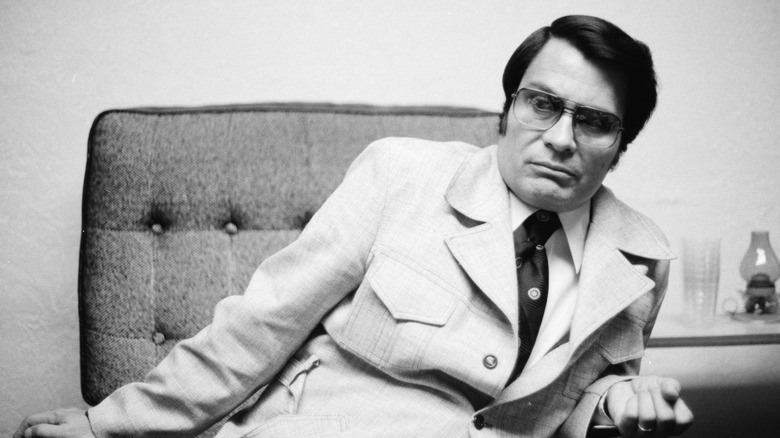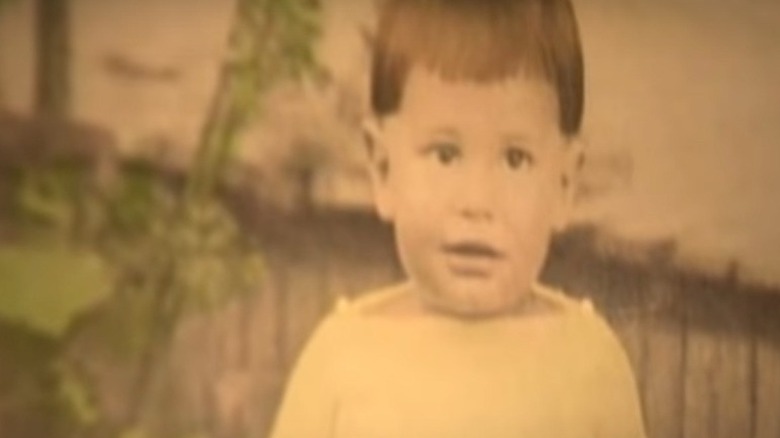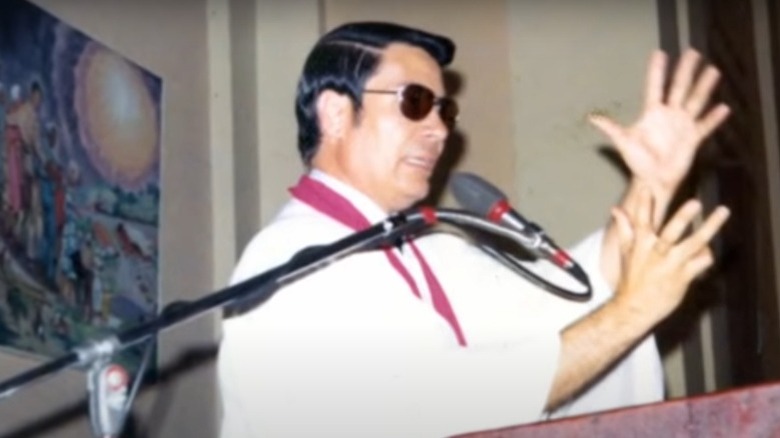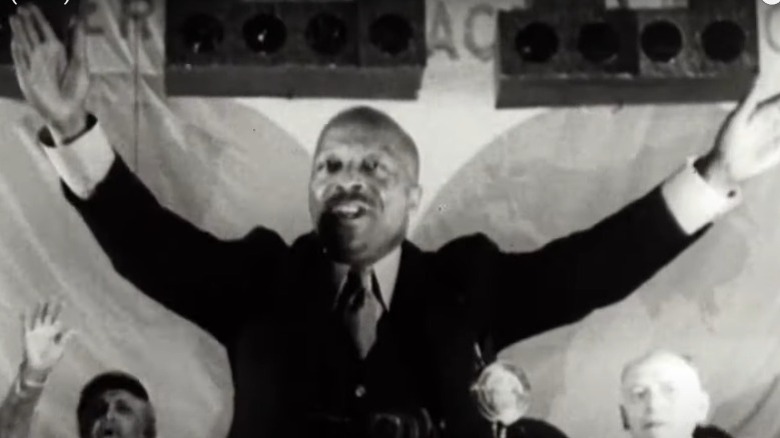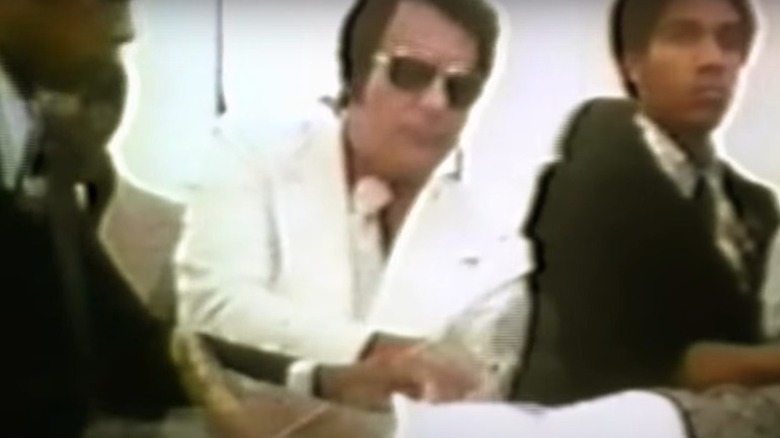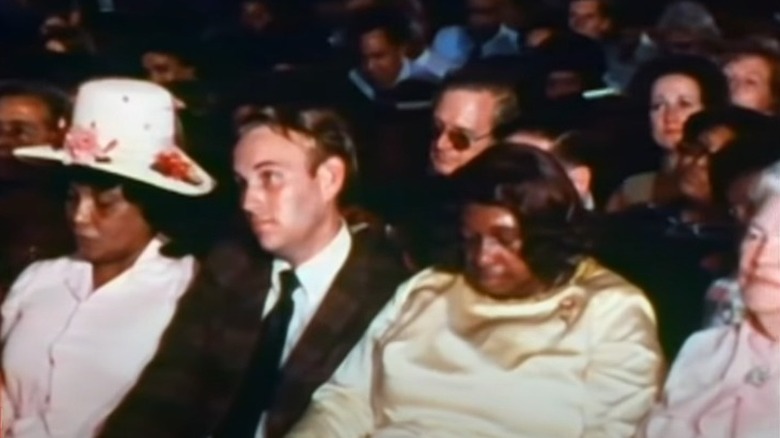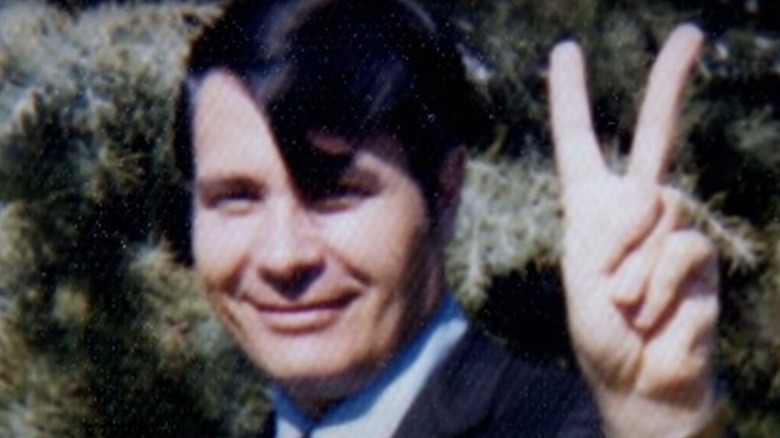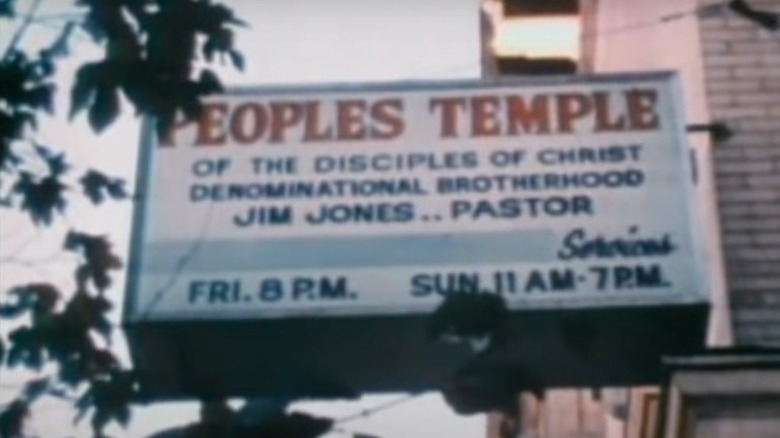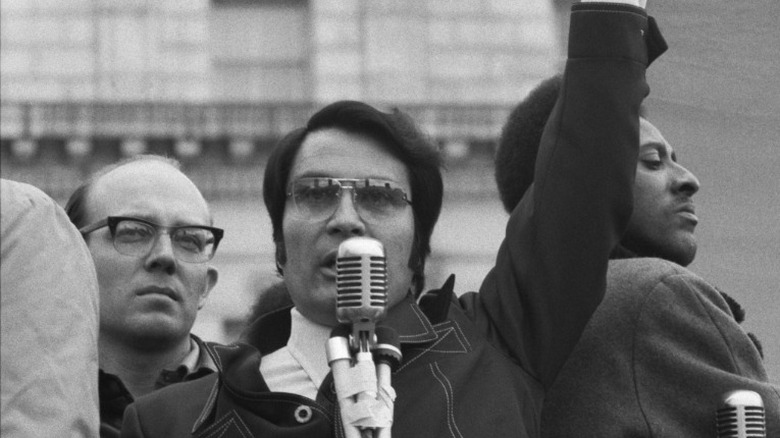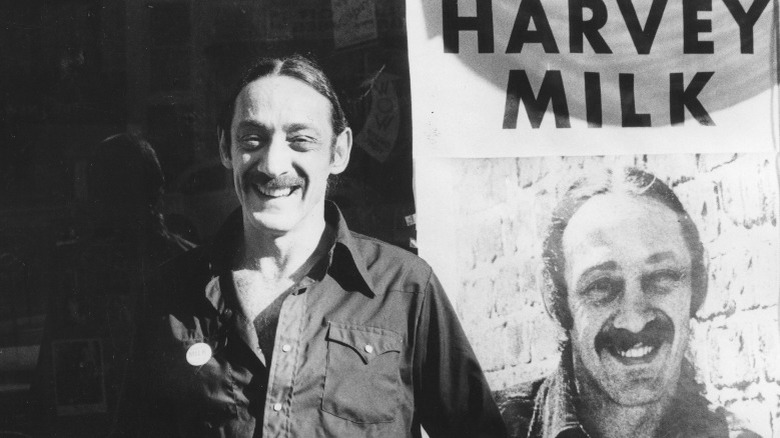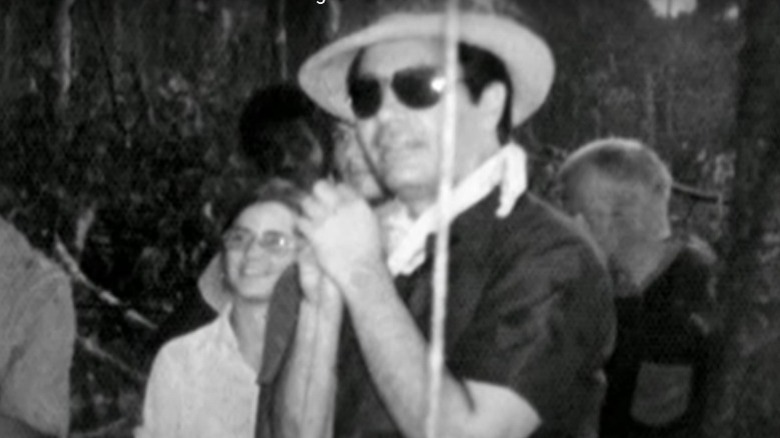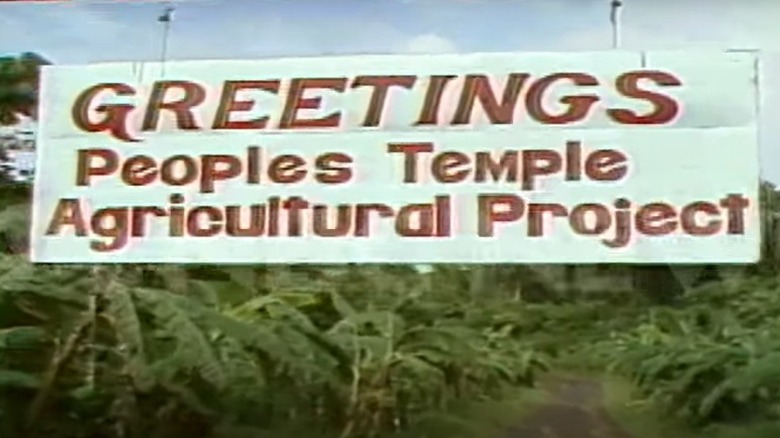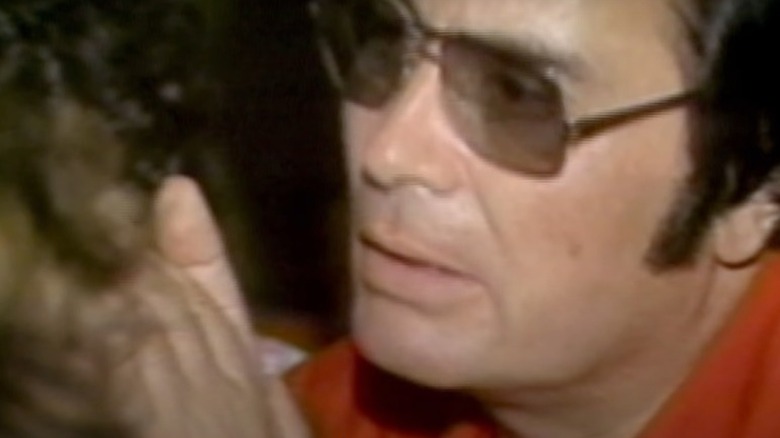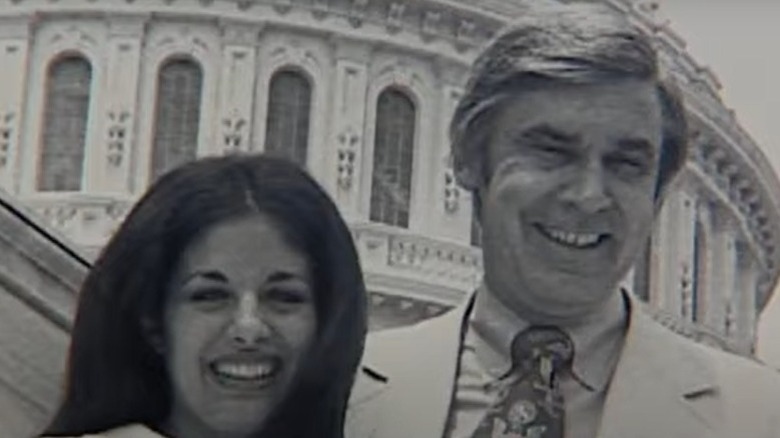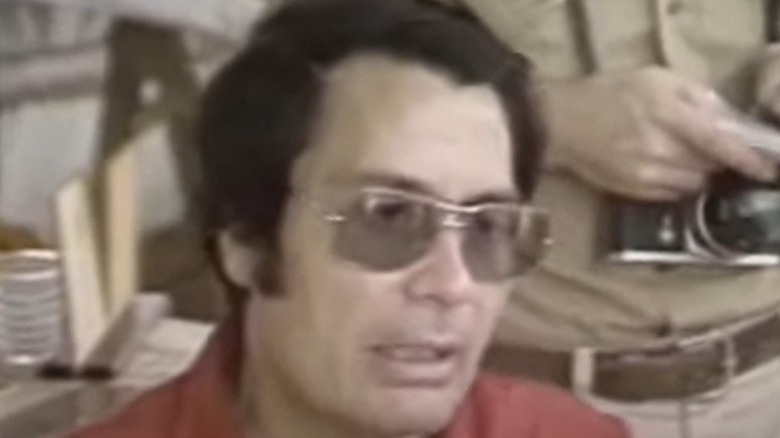The Untold Truth Of Jim Jones And The People's Temple
Religious cult leaders captivate audiences almost as much as the serial killers that have walked among us. Whether it's the grim accounts of the actions of Charles Manson that are told in books and documentaries or the more mainstream brainwashing accounts of The Children of God cult, audiences are both shocked and fascinated not only by the dynamic personalities of the leaders, but also by how otherwise reasonable and intelligent people will cater to their every whim and, in some cases, commit shocking atrocities under their command.
Perhaps no cult leader of the modern era is more known that the late Reverend Jim Jones. In 1978, Jones led a mass suicide of nearly 1,000 of his followers at his cult compound in South America. Known as "The Jonestown Massacre," this event not only marked the largest mass suicide in modern history (via People) but was also the largest number of American civilian lives lost during a single event until it was surpassed by the September 11 attacks 23 years later (via Rolling Stone).
The untold truth of Jones traces his roots from a poor kid in rural Indiana, through his rise as a member of the progressive political machine in 1970s San Francisco, to his faux Utopian compound deep in the jungles of South America.
Jones was born into poverty
Jim Jones was born May 13, 1931, in the unincorporated community of Crete, Indiana (per Biography). His father, James Thurman Jones, served in the United States military during World War I years before and suffered a debilitating injury. The elder Jones was the victim of a mustard gas attack during the war which later left him disabled and unable to work (via PBS).
The young Jones was mostly left to his own devices during his early years. To provide some financial support for their struggling family, his mother, Lynetta Jones, was forced to work a variety of odd jobs. Jones later recalled his formative years to his congregation, claiming that he was the product of a mother who was never home and a father who had little interest in him. "I didn't have any love given to me — I didn't know what the hell love was," he stated in a sermon.
Jones began practicing a variety of faiths at a young age
One such person that did take an interest in Jim Jones during his childhood was a deeply religious neighbor. Biography tells us that for years this neighbor woman would regularly take him to attend Sunday church services with her. This may have been responsible for the fascination that Jones developed with a variety of religious faiths at such a young age. By the time he was 10 years old, Jones began attending the church services of any denomination that was available to him. Living in Lynn, Indiana at this time, Jones had a larger variety of churches to select from. Though his household was largely areligious, he came from both Baptist and Quaker roots. And while he attended the services those denominations provided for the community, Jones also explored the Church of the Nazarene, Apostolic Christianity, and the Pentecostal services (per PBS). He would begin immersing himself in one church, but would soon find himself "disillusioned," causing the curious boy to move on to whatever church was next on the list.
Around this time, Jones also struck up a friendship with a Pentecostal preacher. The man may have had a powerful influence on Jones as he began to develop as a teenager. Jones was beginning to become adept at preaching himself, as well as showing his ability for being a strong student in school.
Jones was influenced by Father Divine
During his last year of high school, Jim Jones was working as an orderly in a hospital in Richmond, Indiana. He and his mother moved there after she and Jones's father divorced. While working at the hospital, Jones met Marceline Baldwin. PBS reports how this nursing student wed Jones the following year, 1949, after Jones finished his first term of college in Indianapolis. The couple had one child, then begin adopting other children of different races in what Jones would later refer to as his "rainbow family" (via Biography).
After a short stint preaching for the Methodist church, Jones founded his church in 1956. Around this time, Jones began to visit with the famed founder of the Universal Peace Mission Movement from the 1920s, George Baker. Better known as Father Divine, Baker taught his Harlem congregants the ways of economic redistribution, urging them to work together and pool their resources as a way to escape the clutches of poverty. Father Divine also at one time professed to be God, claiming that he held the powers of the supernatural.
Jones became familiar with Father Divine while studying world religions and arranged a series of meetings with the aging spiritual leader. Believer Magazine reports that Jones adopted his preaching tactics and was planning on usurping his congregants upon his death. Recognizing Jones for what he was, his efforts to usurp these followers were thwarted by Mother Divine, who kept him at bay.
Jones was active in the Civil Rights Movement
Jim Jones grew into adulthood in a racially segregated United States. As a young adult, Jones began fighting to end this injustice, with roots that began in the church he was preaching at in 1954. Jones had been preaching at Sommerset Methodist church since 1952, and in 1954, he was pressing church leadership to desegregate and allow African-Americans to worship with the all-white congregation. Historic Indianapolis reports that Jones's efforts were severely rebuffed by those who were in charge of the church, causing him to find a new place to preach.
When he and his wife began the People's Temple church two years later, they organized followers to aid their community's poor and elderly but also focused efforts on pushing for racial equality. Their newly founded church was located in a racially mixed neighborhood in Indianapolis and was the first interracial church in the city.
This led to Jones being appointed as chairman of the Indianapolis Human Rights Commission by Mayor Charles Boswell in 1960. In this role, Jones pushed for and helped desegregate movie theaters, restaurants, and other public places. The Indianapolis Recorder, the first African-American newspaper in the city, praised Jones for his efforts to help bring about racial equality.
Jones moved his People's Temple to California out of fear of nuclear war
As his following grew in his Indianapolis church, Jim Jones began to offer up some strange prophecies. In 1961, Jones claimed he had visions of a nuclear attack on the city of Chicago, the impact and fallout of which was going to also destroy the city of Indianapolis (via Historic Indianapolis). The following year, Jones read an Esquire article that reported that the city of Belo Horizonte, Brazil, was the safest place to be in the world during a nuclear war. Jones moved his wife and kids to Brazil soon after, leaving his congregation in the hands of other members.
But after several years in South America, Jones received the news that the People's Temple was beginning to fall into a state of disarray without him at the helm. Jones and his family returned to Indianapolis in 1965. Back in his church, Jones began preaching about his vision of nuclear attacks destroying the city. Recalling the same Esquire article that sent him packing to Brazil several years before, Jones knew that the author also indicated that the Redwood Valley in California was also a safe place to survive a nuclear attack on the United States. Jones gathered up his flock and moved there later in 1965, settling just north of the town of Ukiah (per PBS). Using money from his congregants and land donated from new members, Jones established a new home base for his People's Temple.
Jim Jones believed in socialism
As he developed from an associate pastor to the leader of his church with thousands of followers, Jim Jones continued to study various political theories. The utopia he envisioned and later led his followers to in Guyana was based on tenements of communal living and socialist ideologies (via San Diego State University). Jones professed that the mutual love his congregants held for one another would at some point supersede the evils of the outside world, which would be aided by communal living in what Jones would refer to as a paradise.
But Jones was no stranger to the ideals of socialism or communism. PBS reports that during World War II, Jones was fascinated by how the Soviet armies were able to stave off invasions by the Nazis. He was also reportedly puzzled at how the alliances between the United States and the Soviet Union did a 180 after the end of the war. Loyalty meant a lot to Jones, and he was angered by how his government turned on a nation that they were united with against the Germans.
Jones also was a proponent of the redistribution of wealth, citing a biblical passage that backed this philosophy. It is from Acts 4:35 and reads "Distribution was made unto every man according as he had need.".
The church grew to 5000 members
Not long after Jim Jones and his followers invaded rural Northern California and made homes for themselves in Ukiah and other smaller communities in the Redwood Valley, the People's Temple began to grow. Jones opened a church in San Francisco, attracting followers of different backgrounds than those he had brought with him from Indiana. His original congregants were mostly from lower-income households. But most of those who began attending People's Temple services in California were cut from a different cloth. The message of equality and community that Jones was preaching attracted progressive middle-class whites that had been active in the anti-Vietnam War movement as well as African-Americans from all classes that had been fighting during the ongoing Civil Rights Movement (per PBS).
According to the Critical Dictionary of Apocalyptic and Millenarian Movements, Jones had a following that eventually grew to over 5,000 members that were spread across multiple churches in California.
The People's Temple helped get Mayor Moscone elected.
The growth of the People's Temple in the early 1970s and the reputation Jim Jones was earning as a progressive began to attract the attention of civic leaders in San Francisco. PBS reports that Jones and his church were actively donating time and money to multiple social causes, including the NAACP, the Ecumenical Peace Institute, and a police widows' fund. Jones was also proving that his army of followers was able to mount a campaign on the streets of the city, doing literature drops and papering the neighborhoods with fliers that brought attention to whatever the cause de jour was.
The diversity of his followers and their street campaign tactics attracted the interest of San Francisco mayoral candidate George Moscone. Moscone, who was attempting to be a champion of racial and sexual equality, met with Jones and his senior campaign advisor during the 1975 election season. Salon reports that though the two men were skeptical of getting too involved with a religious organization, they were later impressed that Jones was able to amass more than 200 of his followers to fan out and relentlessly campaign for him in neighborhoods across the city.
This helped Moscone finish first in the field of candidates that were vying for the office of Mayor. During the December runoff election, Jones had nearly 1,000 followers out on the campaign trail for Moscone, who wound up narrowly winning the office by 4,000 votes.
Harvey Milk was an admirer of Jim Jones
During the time Jim Jones spent in San Francisco, he was able to get the admiration and support of many progressives. Aside from Mayor George Moscone, Jones received compliments from the likes of state assembly speaker Willie Brown, as well as future first lady Rosalynn Carter (per PBS). Carter was so taken in by Jones that they dined together, spoke frequently, and even allowed him to introduce her at a campaign rally.
One social justice icon from that era that also held great admiration for Jones was Harvey Milk. Milk, a pioneer for LGBTQ rights, became familiar with Jones in the early 1970s. Milk was no stranger to the People's Temple, where he used to host political rallies in his bid to become elected to the Board of Supervisors in San Francisco (per Time Magazine).
Salon reports that Milk sought Jones' approval while a candidate. After his electoral victory, Jones became mired in a controversy in which a former congregant was seeking government help against Jones, who was reported to have illegally taken the ex-congregant's 6-year-old child to the People's Temple compound in Guyana (via SDSU). Writing to then-president Jimmy Carter, Milk sang praises for his supporter Jones, sending words to him that Milk might soon regret. They read, in part "Rev. Jones is widely known in the minority communities here and elsewhere as a man of the highest character, who has undertaken constructive remedies for social problems which have been amazing in their scope and effectiveness" (via SDSU).
Jones was arrested for indecent exposure
As Jim Jones' star was rising, he was beginning to come under scrutiny by some members of the public. There were whisperings of sexual abuse at the People's Temple, as well as secret affairs that Jones was having with both male and female worshipers (via People). A&E tells us that Jones also had a drug problem. Though he forbid recreational drug use amongst his followers, Jones was privately using both amphetamines and tranquilizers. When he was unable to secure these drugs on his own, he would get them from followers that he trusted, but only after forcing them to swear to secrecy. He also employed the connections of his followers that were in the medical field to procure the wares of his addictions.
Though these scandals were not largely public until after his death, Jones did get himself mired in one incident that led to his arrest in 1973. Jones was arrested in a San Francisco movie theater for lewd behavior after he was caught masturbating in front of an undercover police officer (via Montreal Gazette). Mysteriously, the case against Jones was dismissed at the request of the district attorney's office. The court records were ordered sealed, and the records of the arrest were ordered destroyed.
Jones was trying to build a paradise in the jungle
Jim Jones bought the property in Guyana in 1974 in hopes of establishing a compound there. 10 years prior, Jones and his family had visited this country when they were living in neighboring Brazil (via Historic Indianapolis). In 1977, as things were beginning to unravel for Jones and the People's Temple in San Francisco, he moved nearly 1,000 followers to a compound in this South American country (per PBS). With allegations of sexual and physical abuse mounting against him and members of his inner circle beginning to abandon him, Jones may have known his time without criminal charges was drawing to a close.
With his flock, he established what was promised to be a utopia, which he dubbed "Jonestown." But Biography reports that it was anything but a paradise, comparing Jonestown to a prison work camp. He had armed guards all over his compound. His followers were worked hard and received little food in return. What's more, they weren't allowed to leave.
Adding to the cruel atmosphere was Jones's voice being spoken over loudspeakers all over the compound, preaching sermons that were mirroring the delusions fueled by his growing paranoia and his addiction issues.
Jones led his followers on suicide drills
Jim Jones was becoming increasingly paranoid that one of two things was going to happen to him. He feared that he would be ousted from his position by a plot from his followers (via Biography), or that his Jonestown compound would be invaded by the Guyanese government forces (per A&E).
Survivor Tracy Jones was 12 years old and living with her mother at Jonestown. She recalls Jones holding mass suicide drills that were called "White Nights" (per People). During these drills, congregants' days were interrupted when they were told that snipers were setting their sights on Jones and that the armies were invading their homes. Cups of flavored punch that supposedly contained poison were set out, with the instructions given to his followers to drink from them and end their time on Earth. Claiming that the children would be taken away and tortured, they were forced to drink from these cups, too. But after about 45 minutes elapsed and the followers were still alive, Jones assured them that they had not been poisoned but had been instead given a loyalty test, which they had all passed (via Biography).
It could be argued that these drills desensitized the followers at Jonestown to their eventual fate.
Jones had a Congressman and several reporters murdered
Two former members of the People's Temple were in the United States publicly bashing the cult leader to any media outlet that would listen. One former member was Grace Stoen, who was demanding that the United States government intervene and retrieve her 6-year-old child that Jim Jones had taken to Guyana (per Biography). With political pressures mounting and media reports painting a sordid picture of Jones, California Congressman Leo Ryan decided to fly to Guyana himself to see what was going on. With a camera crew and reporters in tow, Ryan visited the compound on November 18, 1978. While there, he insisted that anyone who wanted to leave could safely do so with him.
After gathering defectors from Jonestown, Ryan and his crew were driven to an airstrip in nearby Port Kaituma. While boarding the plane home, People's Temple guards opened fire on the party. Five were killed, including Ryan, NBC reporter Don Harris, NBC cameraman Bob Brown, and San Francisco Examiner photographer Greg Robinson. One defector, Patricia Parks, was killed, and two others were seriously wounded.
The final night at Jonestown
Knowing the end was near, Jim Jones ordered a mixture of cyanide and valium be stirred into a grape-flavored punch. The toxic beverage was poured into cups and distributed among the more than 900 followers than remained (per Biography).
It was the children who began to die first. Perhaps until the youngest among them began falling, some adults thought this was all another drill to test their loyalty. The few that did survive tell of how those who were hesitant to drink were forced to by armed guards. History tells us that 909 people died that day, with one-third of the victims being children. Jones himself didn't drink his punch. When his body was later discovered, it was determined that he died from a gunshot wound to the head. Whether it was self-inflicted or ordered from one of his inner circles hasn't been determined.
One chilling remnant of that terrifying evening was a recording recovered from the compound that was running during the entire suicide event. Dubbed the "Death Tape," it contains the final sermon (via SDSU) of the preacher from a small Indiana town, delivered while nearly 1,000 of his followers lay dying at his command.
